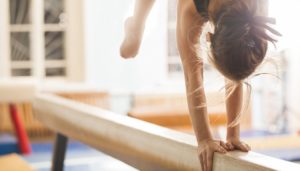Whether you’ve had a dance studio for years or are just now preparing to open a studio, at some point you’ll consider installing proper flooring. Whenever you’re looking for dance studio flooring, there are several important things you’ll have to keep in mind related to the safety of your students, your budget, and possibly even restrictions imposed by the building your studio is in.
The truth is there’s a lot that goes into a decision like this, and it’s likely more complicated than you may realize. In this article, we’ll touch on what you need to know about dance studio flooring: materials, installation, maintenance, and beyond. We’ve got a lot of ground to cover (pun intended), so let’s dive in!
Start With Your Budget For Dance Studio Flooring
Some dance studio owners make the mistake of opting for the least expensive materials for their dance floor installation without any other considerations. Whoa there! Before you assume the best bet is to purchase the cheapest floor and be done with it, consider the following:
If you go with the cheapest floor, what happens if it starts getting scuffed up and dented, or begins to separate and come up off the ground? You might need to replace it sooner than you would have if you’d chosen a higher quality, and perhaps more expensive, dance studio flooring material.
You might be able to repair the damaged sections here and there, but depending on how quickly the flooring becomes unsafe or uncomfortable to dance on, there is a chance you will have to replace most, if not all of it.
Another problem with cheap dance floor material is that a dancer could get hurt while learning and dancing on it. When an injury happens, and you’re called into court, the jury could rule in favor of the injured party if you didn’t have their safety in mind when picking your floors. With this possible scenario alone, can you really afford the risk of a bargain-priced dance floor or installation job?
This brings us to our next point: don’t skimp on the installation, either. Make sure to use qualified people for your dance floor installation. The last thing you want is someone getting hurt, or added unnecessary repairs due to subpar work.
Dancers at risk for potential injury, as well as the possibility of prematurely needing replacement flooring, are just the first two things that come to mind if you don’t do your due diligence. Suddenly that “cheap flooring” got a lot more expensive!
How To Find The Right Dance Floor Material
After you’ve determined your budget for your new dance studio flooring project, it’s time to dig into the following factors and questions to guide your research when picking the right dance floor material.
1. Look for dance floors with the right give
When someone steps on your floor, it shouldn’t be too hard, and it shouldn’t be too soft. In the words of Goldilocks, it should be “just right.”
When you choose dance floor material that is too hard, it can cause repetitive strain injuries. On the flip side, material that’s too soft is tiring to work on and can actually lead to muscle fatigue since moving on it requires more effort. As your students move on the dance floor, it shouldn’t be springy like a trampoline. However, it should be bouncy enough to absorb the energy of falls that can, and probably will, happen while dancing.
2. Consider the classes you offer
The dance floor material you choose might be dependent on the type of dance you offer.
For tap dancing classes, you’ll want the act of tapping to produce a clear and concise sound. For many other types of dance, you’ll want little to no noise at all. Some dance floor material, such as thick vinyl, softens sounds, as opposed to a hardwood floor that can produce a clean and crisp sound that you’ll want to hear with tap classes.
While the acoustics of your room will have an impact on the sound as well, it shouldn’t be your flooring causing a distortion in noise. Therefore, you’ll need to take that into account when selecting your dance studio flooring.
3. Provide the right level of traction
You want your dancers to glide easily on the floor, but not slip and slide uncontrollably. At the same time, too much slip resistance can actually block movement, and as a result, lead to an injury. One of the most common injuries from this is a twisted ankle. Injuries like this could take a dancer out for a few weeks, months, or even an entire season depending on the severity.
So ask around, do some research, find out what other studios have installed, and make sure the amount of resistance you choose coincides with the styles of dance you offer.
4. “Aim for area-elastic, not point-elastic
According to Tarkett Sports, “An area-elastic floor disperses energy over a wide surface area, while a point-elastic sports floor reacts in a more localized area.”
Area-elastic floors are better able to absorb the impact when a dancer lands on it. Point-elastic floors simply don’t have as much shock absorption. Even in the short-term, dancing on a point-elastic floor could lead to mild pain leading up to significant injury from repetitive movements in practice.
5. Choose between sprung dance floors and semi-sprung floors
A sprung floor is one that will provide some bounce, and also flex under impact so that it feels softer to move and dance on. The main benefit of having a sprung floor is that it will absorb the shock to a performer’s joints as they dance on the floor. An added benefit of having a sprung floor is that if a performer were to fall on it, there would be a significantly reduced chance of injury upon impact compared with falling on a floor with no spring.
Though dancers need a floor that will absorb shock to their joints, not all types of dance require a fully sprung floor.
In fact, too much spring can be problematic depending on the type of dance being performed on the surface. As a result, semi-sprung floors are growing in popularity for dance studio owners. Semi-sprung floors are designed to dampen bounce, so they won’t feel as springy as a trampoline, but they also give the performer just enough bounce to prevent injury and muscle strain.
In some cases, dance studio owners opt to not install a sprung floor due to budget. However, this could be a mistake, as the lack of spring in flooring can lead to liability issues. Your dancers must feel safe, and you need to prevent as many injuries as possible. You might be able to get away with installing a semi-sprung floor, which is often less expensive, but don’t skimp by opting completely out of having some form of a sprung floor.
6. Decide on your dance studio flooring material
Beyond these safety factors, take time to think about the material you’ll use.
For example, some dance studio owners choose hardwood because of the traditional look and feel of it. Hardwood flooring can be difficult to maintain though, as it tends to buckle, break, and splinter in certain conditions. For example, the heat and humidity in a place like Louisiana or Florida could cause wood to expand, mold, and even rot leading to costly repairs.
Your best option for the material you choose will likely depend on the area your studio is located in. Research all factors of your dance floor material with the manufacturer, as they may be able to give you the best recommendations for your unique setting. Shop around, get a general consensus, and make your decision from there.
7. Look up at your ceilings
This may seem odd since we’re discussing dance floor installation but, the height of your ceilings can actually have a significant impact on the flooring you choose.
According to the Center for Educator Development in Fine Arts (CEDFA), “A ceiling height of 20-24 feet is ideal, but 16 feet is the minimum height.”
The reason for this is a dancer will need enough headroom so they never feel inhibited when jumping or doing other dance moves. Additionally, some dances require formations that involve dancers standing on the backs or shoulders of other dancers.
At first blush, 16 feet seems easily achievable in most dance studio spaces. Then again, if you choose flooring that is 50 to 100 mm thick, you’re losing roughly a sixth to a third of a foot. And yes, some semi-sprung and sprung floors can be up to 100 mm depending on how much padding you install underneath the surface.
Therefore, if you’re in a building that has lower ceilings, the thickness of your chosen dance floor material could present a problem.
8. Choose between permanent floors and portable dance studio flooring?
If you are renting a studio, permanent flooring may not be an option. This is an important discussion you will need to have with your landlord.
Permanent floors are typically safer, and more durable than portable ones. On the other hand, permanent floors are also more expensive in nearly all cases (for good and obvious reason!).
9. Look at environmental factors
When considering your dance studio flooring, you also need to think about things like:
- The moisture of the building
- The strength and construction of the foundation you will be installing the floor on
- Whether or not there will be doors that need to swing open onto the floor
- If you need to install ramps or barres that will impact how thick your flooring is
- If there is a heating or cooling system under the floor thatcould change the condition of your dance floor material over time
How To Manage Dance Studio Flooring Maintenance
Once you have finally installed your dance studio flooring, whether it’s permanent or portable, proper maintenance is crucial when it comes to how long it will last. After all, the things we take the best care of, have the most endurance.
Dance Teacher Magazine reported that “Maintenance of your floor is key. Make a schedule to dry-mop every day, wet-mop every week, and give a full cleaning twice a year during your studio breaks. With good maintenance, floors can last you 10 to 15 years.”
They went onto say that permanent floors are the easiest to maintain compared with portable ones “because the seams are welded together to prevent water damage.”
Of course, the materials you use to wet-mop and deep clean your floors may be dependent on the type of flooring you have installed. Soap and hot water, let alone wet-mopping at all, might not be a good idea for wood, for example.
You’ll want to look into best practices for maintenance with your flooring manufacturer as well. They might try to sell you their specific brand of cleaner, but press them for alternatives, and they will likely give you plenty of options for getting the longest life out of your flooring.
Laying The Groundwork For A Successful Studio
The options may be overwhelming when it comes to installing dance studio flooring. However, making the wrong choice could cost you. That’s why it’s so important to think about all the facts and factors before committing to this choice, as well as, many of the other elements of opening a dance studio. Beyond the flooring, mirrors, and barres, there’s plenty to manage as a studio owner. Studio Director has made it easier to streamline and automate your key administrative tasks so you can focus on the important work of building your studio. From billing to class registration, we help you manage it all.


